warning light DODGE DURANGO 2018 Vehicle Warranty
[x] Cancel search | Manufacturer: DODGE, Model Year: 2018, Model line: DURANGO, Model: DODGE DURANGO 2018Pages: 316, PDF Size: 3.15 MB
Page 254 of 316

WARNING!(Continued)
•LT-metric tires carry their load at higher inflation pressures and do
not always have adequate load capacity to replace P-metric tires of
the same size.
•After reducing a P-metric tire’s load rating by dividing by 1.1 for
fitment on a Light Truck, the P-metric tire may not offer sufficient
load capacity to replace an LT-metric tire of the same size.
•Contact your Toyo Tires dealer or Toyo Tires Technical Service for
help determining how to choose a proper replacement size.
•Driving with underinflated or overloaded tires may result in
immediate tire failure, which can cause an accident and could lead
to serious personal injury or death.
When a P-metric or metric tire is installed on a light truck (SUV, pickup,
minivan), the load rating is reduced by dividing by 1.1. (This load
reduction factor is prescribed by Federal Motor Vehicle Safety Standards
(FMVSS) and is based on the expectation that passenger-type tires may
experience more severe loading and usage conditions when applied to
light trucks.) For example, 305/50R20 has a maximum load capacity of
3086 lbs. If this tire is fitted to a light truck, the actual allowable load for
the tire is 2805 lbs. (3086 lbs. divided by 1.1).
Consult the load and inflation charts that can be found at
www.toyotires.com. Contact Toyo Tires Technical Service with any tire
replacement questions: 1-800-442-8696 (Pacific Time) or 1-888-444-8696
(Eastern Time).
TOYO TIRES – LIMITED WARRANTY
253
Page 255 of 316
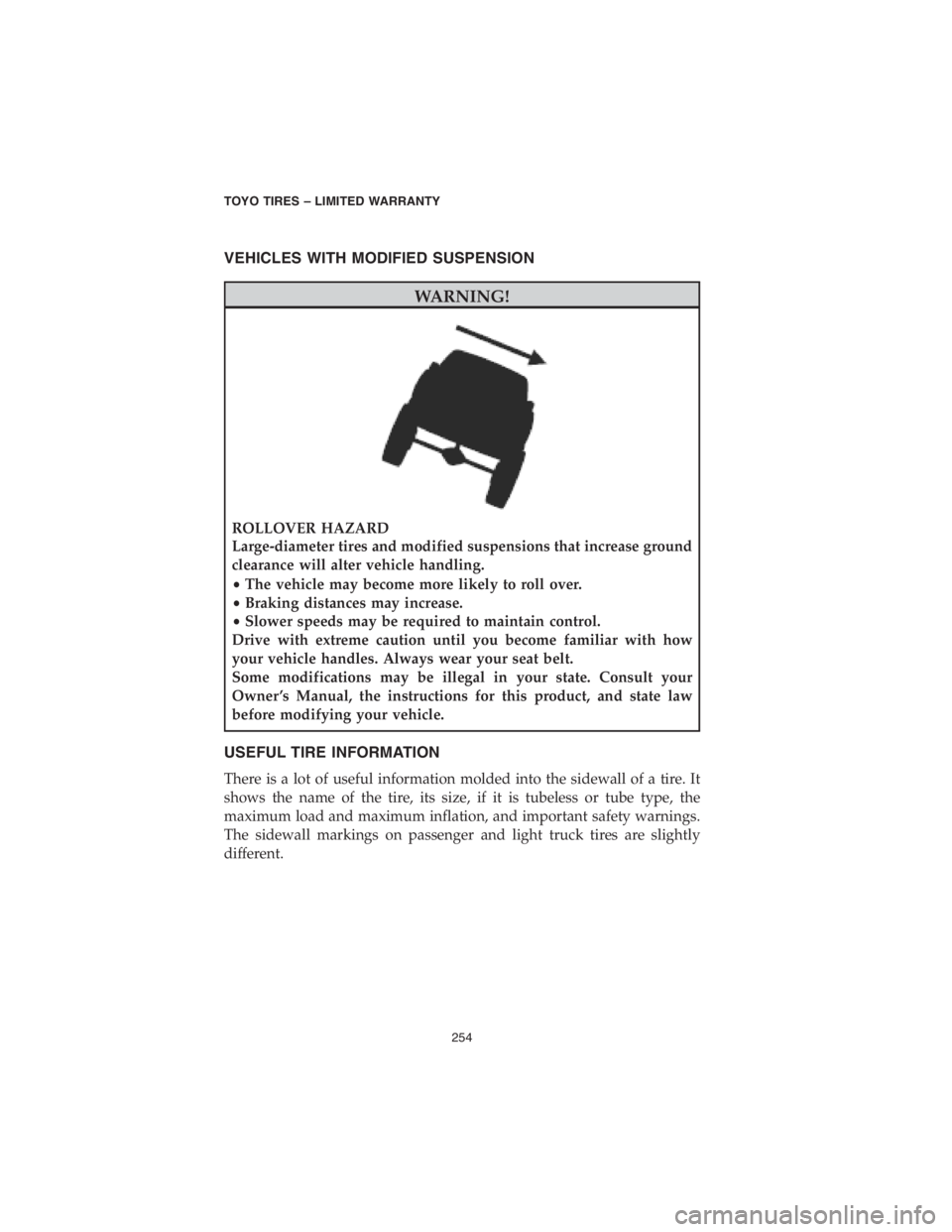
VEHICLES WITH MODIFIED SUSPENSION
WARNING!
ROLLOVER HAZARD
Large-diameter tires and modified suspensions that increase ground
clearance will alter vehicle handling.
•The vehicle may become more likely to roll over.
•Braking distances may increase.
•Slower speeds may be required to maintain control.
Drive with extreme caution until you become familiar with how
your vehicle handles. Always wear your seat belt.
Some modifications may be illegal in your state. Consult your
Owner ’s Manual, the instructions for this product, and state law
before modifying your vehicle.
USEFUL TIRE INFORMATION
There is a lot of useful information molded into the sidewall of a tire. It
shows the name of the tire, its size, if it is tubeless or tube type, the
maximum load and maximum inflation, and important safety warnings.
The sidewall markings on passenger and light truck tires are slightly
different.
TOYO TIRES – LIMITED WARRANTY
254
Page 276 of 316
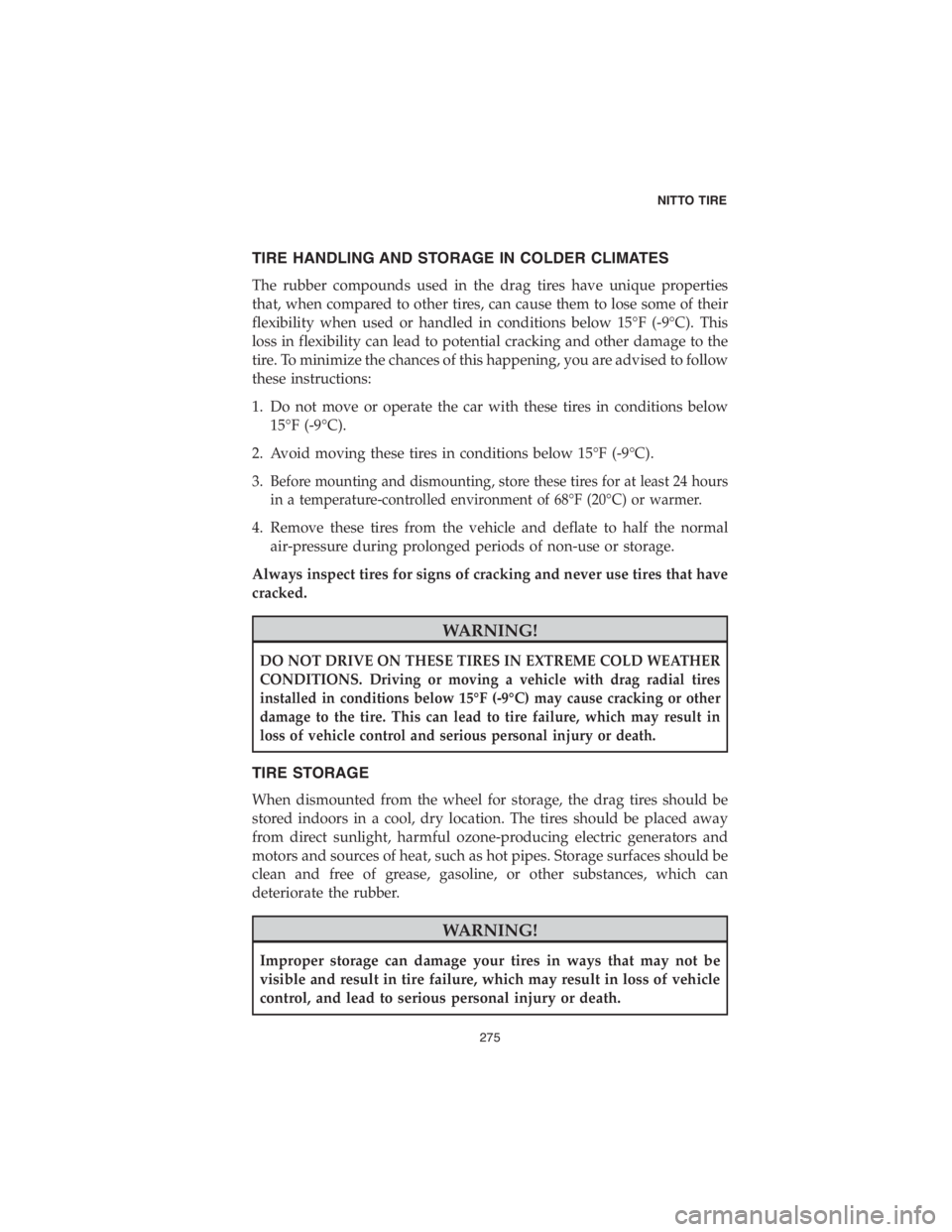
TIRE HANDLING AND STORAGE IN COLDER CLIMATES
The rubber compounds used in the drag tires have unique properties
that, when compared to other tires, can cause them to lose some of their
flexibility when used or handled in conditions below 15°F (-9°C). This
loss in flexibility can lead to potential cracking and other damage to the
tire. To minimize the chances of this happening, you are advised to follow
these instructions:
1. Do not move or operate the car with these tires in conditions below
15°F (-9°C).
2. Avoid moving these tires in conditions below 15°F (-9°C).
3.
Before mounting and dismounting, store these tires for at least 24 hours
in a temperature-controlled environment of 68°F (20°C) or warmer.
4. Remove these tires from the vehicle and deflate to half the normal
air-pressure during prolonged periods of non-use or storage.
Always inspect tires for signs of cracking and never use tires that have
cracked.
WARNING!
DO NOT DRIVE ON THESE TIRES IN EXTREME COLD WEATHER
CONDITIONS. Driving or moving a vehicle with drag radial tires
installed in conditions below 15°F (-9°C) may cause cracking or other
damage to the tire. This can lead to tire failure, which may result in
loss of vehicle control and serious personal injury or death.
TIRE STORAGE
When dismounted from the wheel for storage, the drag tires should be
stored indoors in a cool, dry location. The tires should be placed away
from direct sunlight, harmful ozone-producing electric generators and
motors and sources of heat, such as hot pipes. Storage surfaces should be
clean and free of grease, gasoline, or other substances, which can
deteriorate the rubber.
WARNING!
Improper storage can damage your tires in ways that may not be
visible and result in tire failure, which may result in loss of vehicle
control, and lead to serious personal injury or death.
NITTO TIRE
275
Page 289 of 316
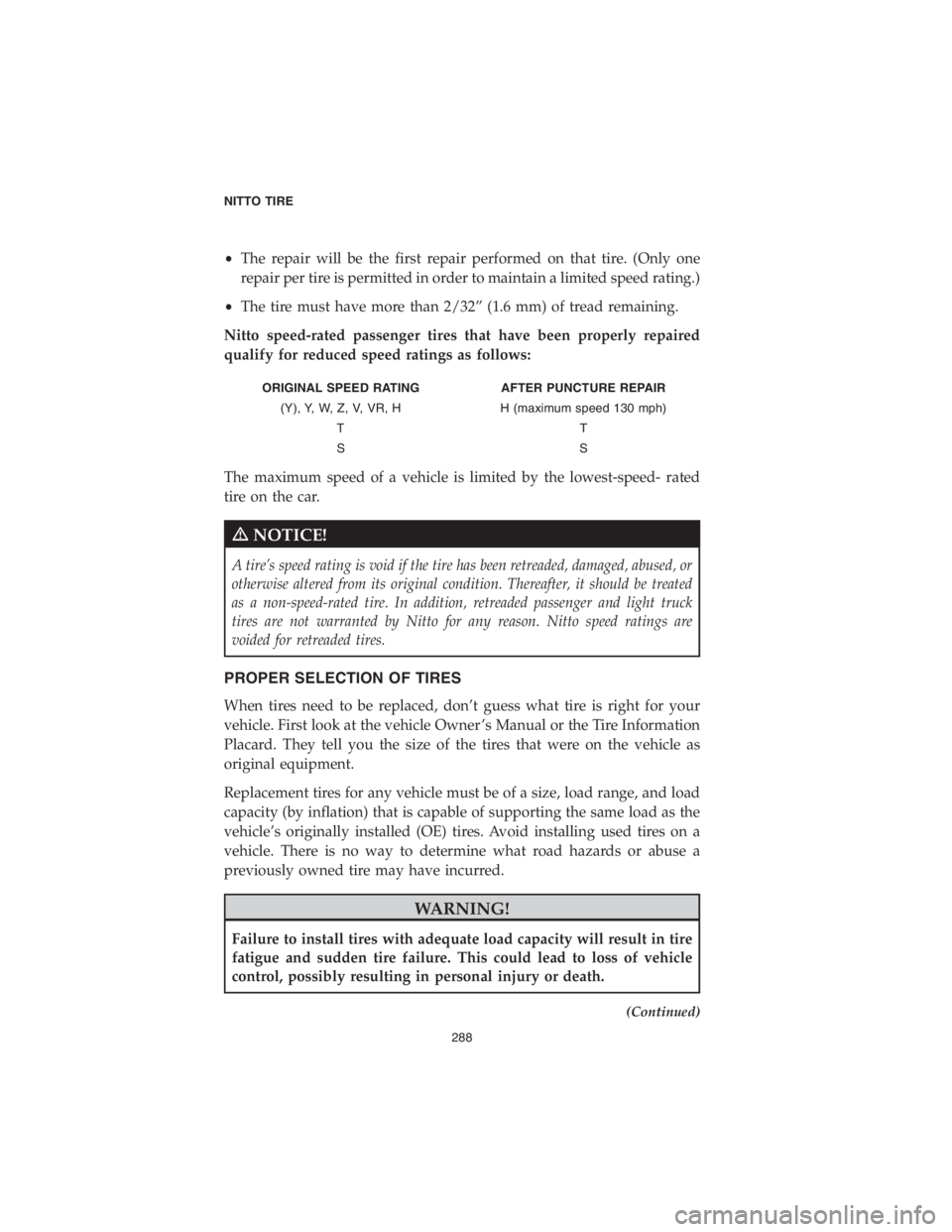
•The repair will be the first repair performed on that tire. (Only one
repair per tire is permitted in order to maintain a limited speed rating.)
•The tire must have more than 2/32” (1.6 mm) of tread remaining.
Nitto speed-rated passenger tires that have been properly repaired
qualify for reduced speed ratings as follows:
ORIGINAL SPEED RATING AFTER PUNCTURE REPAIR
(Y), Y, W, Z, V, VR, H H (maximum speed 130 mph)
TT
SS
The maximum speed of a vehicle is limited by the lowest-speed- rated
tire on the car.
mNOTICE!
A tire’s speed rating is void if the tire has been retreaded, damaged, abused, or
otherwise altered from its original condition. Thereafter, it should be treated
as a non-speed-rated tire. In addition, retreaded passenger and light truck
tires are not warranted by Nitto for any reason. Nitto speed ratings are
voided for retreaded tires.
PROPER SELECTION OF TIRES
When tires need to be replaced, don’t guess what tire is right for your
vehicle. First look at the vehicle Owner ’s Manual or the Tire Information
Placard. They tell you the size of the tires that were on the vehicle as
original equipment.
Replacement tires for any vehicle must be of a size, load range, and load
capacity (by inflation) that is capable of supporting the same load as the
vehicle’s originally installed (OE) tires. Avoid installing used tires on a
vehicle. There is no way to determine what road hazards or abuse a
previously owned tire may have incurred.
WARNING!
Failure to install tires with adequate load capacity will result in tire
fatigue and sudden tire failure. This could lead to loss of vehicle
control, possibly resulting in personal injury or death.
(Continued)
NITTO TIRE
288
Page 290 of 316
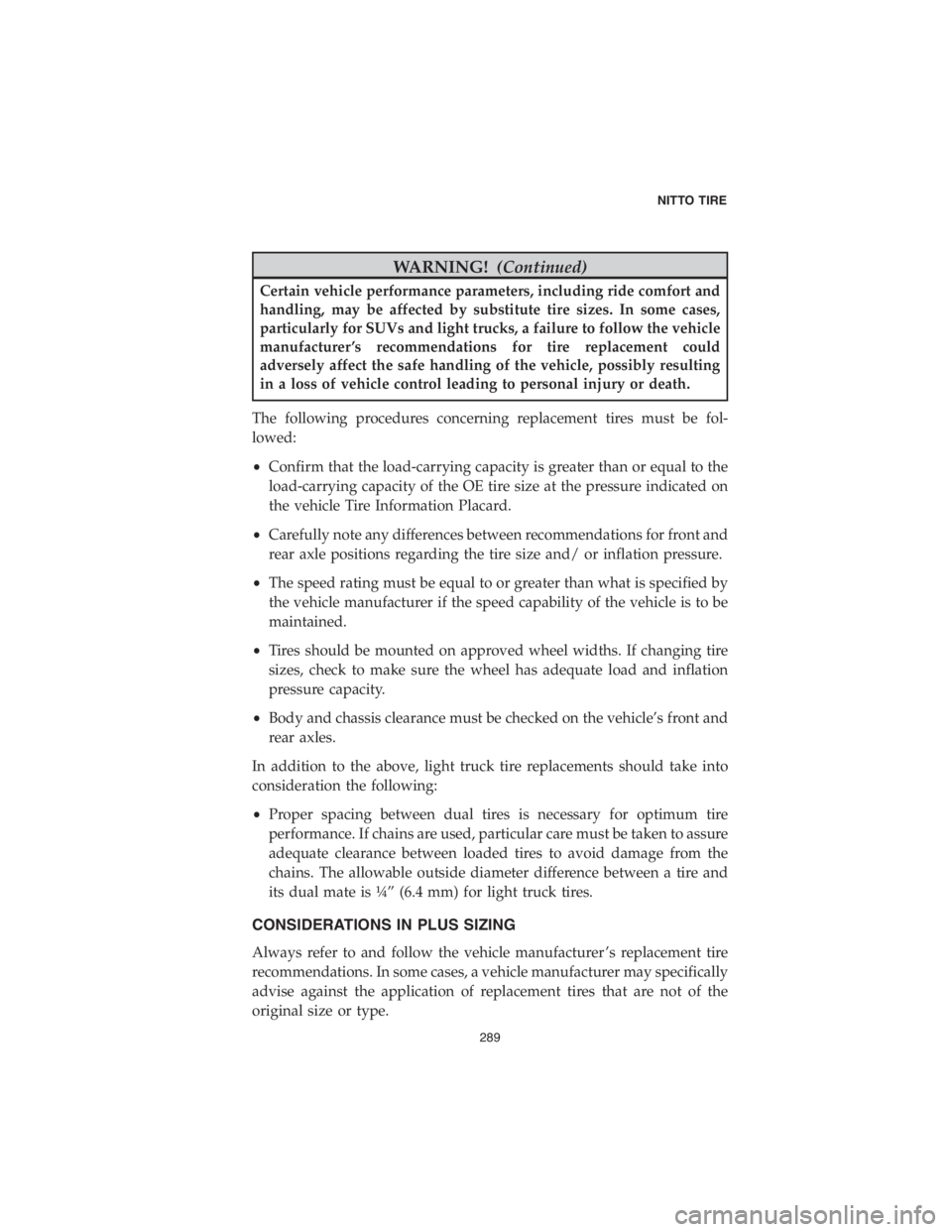
WARNING!(Continued)
Certain vehicle performance parameters, including ride comfort and
handling, may be affected by substitute tire sizes. In some cases,
particularly for SUVs and light trucks, a failure to follow the vehicle
manufacturer ’s recommendations for tire replacement could
adversely affect the safe handling of the vehicle, possibly resulting
in a loss of vehicle control leading to personal injury or death.
The following procedures concerning replacement tires must be fol-
lowed:
•Confirm that the load-carrying capacity is greater than or equal to the
load-carrying capacity of the OE tire size at the pressure indicated on
the vehicle Tire Information Placard.
•Carefully note any differences between recommendations for front and
rear axle positions regarding the tire size and/ or inflation pressure.
•The speed rating must be equal to or greater than what is specified by
the vehicle manufacturer if the speed capability of the vehicle is to be
maintained.
•Tires should be mounted on approved wheel widths. If changing tire
sizes, check to make sure the wheel has adequate load and inflation
pressure capacity.
•Body and chassis clearance must be checked on the vehicle’s front and
rear axles.
In addition to the above, light truck tire replacements should take into
consideration the following:
•Proper spacing between dual tires is necessary for optimum tire
performance. If chains are used, particular care must be taken to assure
adequate clearance between loaded tires to avoid damage from the
chains. The allowable outside diameter difference between a tire and
its dual mate is ¼” (6.4 mm) for light truck tires.
CONSIDERATIONS IN PLUS SIZING
Always refer to and follow the vehicle manufacturer ’s replacement tire
recommendations. In some cases, a vehicle manufacturer may specifically
advise against the application of replacement tires that are not of the
original size or type.
NITTO TIRE
289
Page 291 of 316

TIRE AND WHEEL MATCHING AND MOUNTING
WARNING!
Any attempt to mount a tire on a wheel with a different diameter
will result in an explosion of the tire/wheel assembly that could
cause severe personal injury or death.
Prior to mounting any tire, always check the wheel identification
stamp to verify the correct wheel diameter. Always check the tire
size molded onto the sidewall.
Never exceed 40 psi when seating the tire beads onto the wheel.
Always stand well clear of any tire mounting operation. This is
especially important when the service operator inflates the tire. If
the tire has been improperly mounted, it could burst with explosive
force causing serious personal injury or death.
A new valve stem must be installed on the wheel each time a
worn-out passenger or light truck tire is replaced.
Removing and replacing tires on wheels can be dangerous.
Attempting to mount tires with improper tools or procedures could
result in a tire explosion, causing serious personal injury or death.
This is a job for your authorized Nitto dealer or other qualified tire
service location only.
Serious personal injury or death can result from:
•Failure to select the proper tire and wheel. The tire must match the
width and diameter requirements of the wheel. When mounting
truck type radial tires use only wheels approved for radial tires.
•Failure to inspect both the tire and wheel. The wheel must be free
of cracks, dents, chips, and rust. The tire must be free of bead
damage, cuts, and punctures.
•Failure to follow proper procedures. For proper mounting proce-
dures, consult the Rubber Manufacturers Association’s publication
“Care and Service of Automobile and Light Truck Tires” (ref.:
www.rma.org).
•Exceeding the maximum bead seating pressure of 40 psi. Be
absolutely certain beads are fully seated before adjusting the
inflation pressure to the level recommended for vehicle operation.
Never put flammable substances in the tire/wheel assemblies at any
time. Never put any flammable substance into a tire/wheel assembly
and attempt to ignite it in order to seat the beads.
NITTO TIRE
290
Page 293 of 316
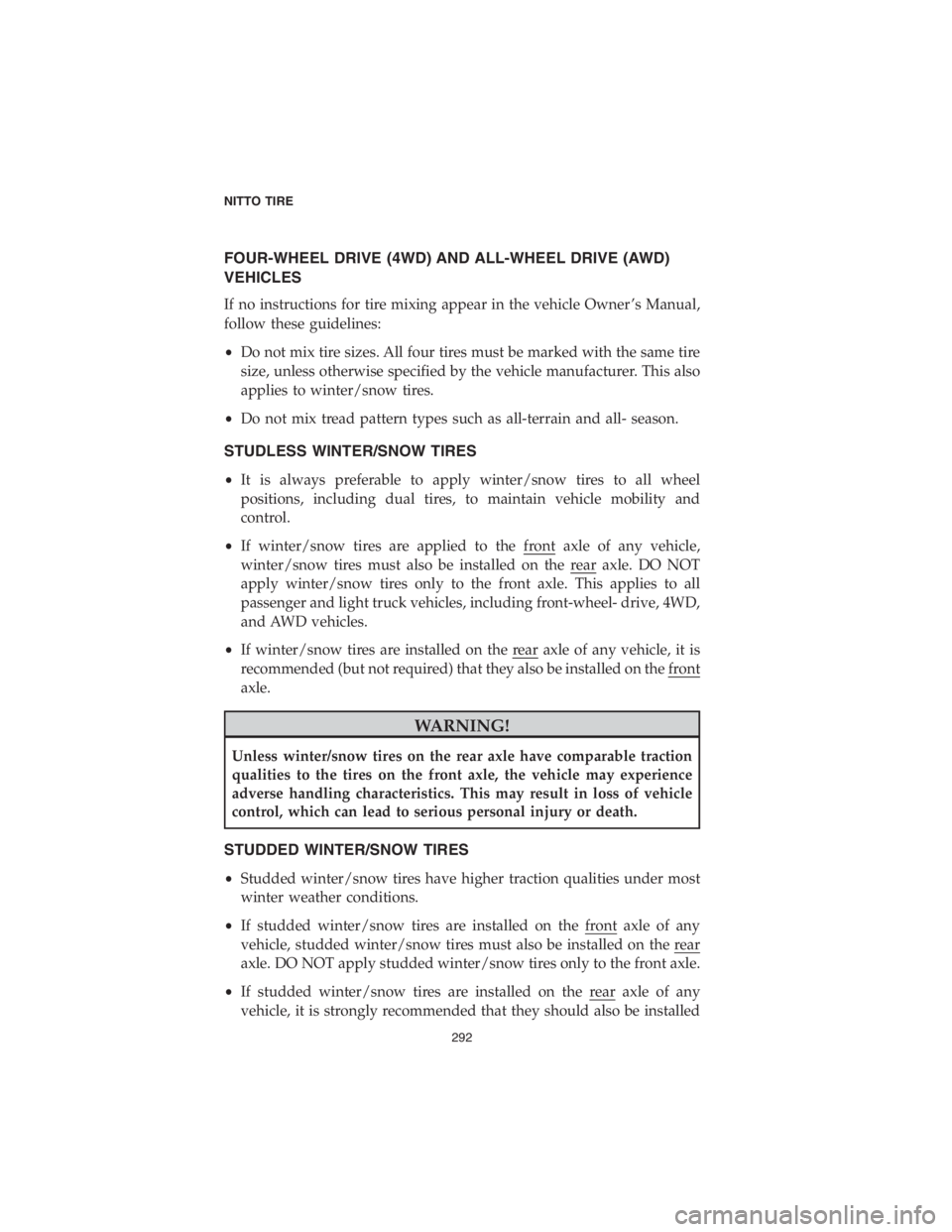
FOUR-WHEEL DRIVE (4WD) AND ALL-WHEEL DRIVE (AWD)
VEHICLES
If no instructions for tire mixing appear in the vehicle Owner ’s Manual,
follow these guidelines:
•Do not mix tire sizes. All four tires must be marked with the same tire
size, unless otherwise specified by the vehicle manufacturer. This also
applies to winter/snow tires.
•Do not mix tread pattern types such as all-terrain and all- season.
STUDLESS WINTER/SNOW TIRES
•It is always preferable to apply winter/snow tires to all wheel
positions, including dual tires, to maintain vehicle mobility and
control.
•If winter/snow tires are applied to the front axle of any vehicle,
winter/snow tires must also be installed on the rear axle. DO NOT
apply winter/snow tires only to the front axle. This applies to all
passenger and light truck vehicles, including front-wheel- drive, 4WD,
and AWD vehicles.
•If winter/snow tires are installed on the rear axle of any vehicle, it is
recommended (but not required) that they also be installed on the front
axle.
WARNING!
Unless winter/snow tires on the rear axle have comparable traction
qualities to the tires on the front axle, the vehicle may experience
adverse handling characteristics. This may result in loss of vehicle
control, which can lead to serious personal injury or death.
STUDDED WINTER/SNOW TIRES
•Studded winter/snow tires have higher traction qualities under most
winter weather conditions.
•If studded winter/snow tires are installed on the front axle of any
vehicle, studded winter/snow tires must also be installed on the rear
axle. DO NOT apply studded winter/snow tires only to the front axle.
•If studded winter/snow tires are installed on the rear axle of any
vehicle, it is strongly recommended that they should also be installed
NITTO TIRE
292
Page 297 of 316
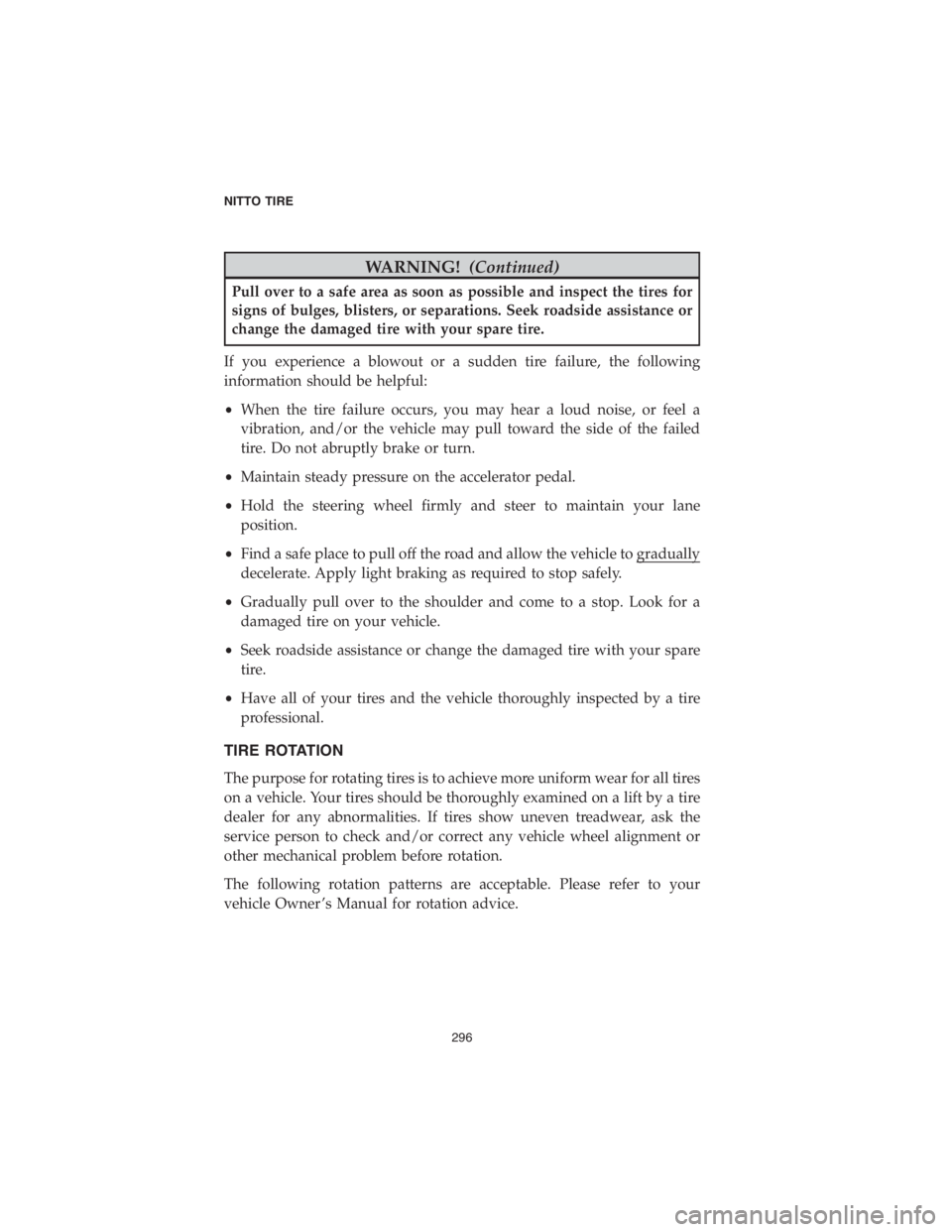
WARNING!(Continued)
Pull over to a safe area as soon as possible and inspect the tires for
signs of bulges, blisters, or separations. Seek roadside assistance or
change the damaged tire with your spare tire.
If you experience a blowout or a sudden tire failure, the following
information should be helpful:
•When the tire failure occurs, you may hear a loud noise, or feel a
vibration, and/or the vehicle may pull toward the side of the failed
tire. Do not abruptly brake or turn.
•Maintain steady pressure on the accelerator pedal.
•Hold the steering wheel firmly and steer to maintain your lane
position.
•Find a safe place to pull off the road and allow the vehicle to gradually
decelerate. Apply light braking as required to stop safely.
•Gradually pull over to the shoulder and come to a stop. Look for a
damaged tire on your vehicle.
•Seek roadside assistance or change the damaged tire with your spare
tire.
•Have all of your tires and the vehicle thoroughly inspected by a tire
professional.
TIRE ROTATION
The purpose for rotating tires is to achieve more uniform wear for all tires
on a vehicle. Your tires should be thoroughly examined on a lift by a tire
dealer for any abnormalities. If tires show uneven treadwear, ask the
service person to check and/or correct any vehicle wheel alignment or
other mechanical problem before rotation.
The following rotation patterns are acceptable. Please refer to your
vehicle Owner ’s Manual for rotation advice.
NITTO TIRE
296
Page 308 of 316
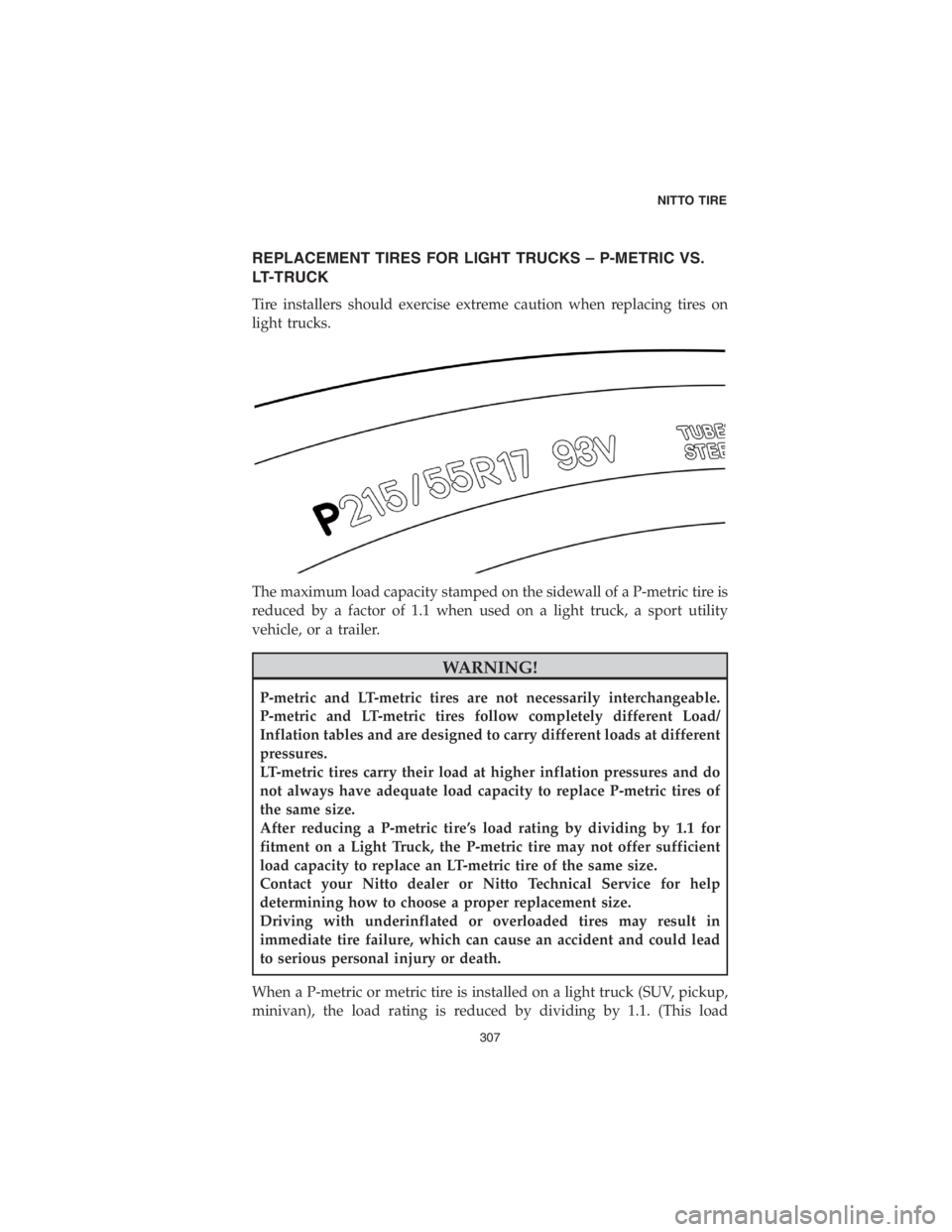
REPLACEMENT TIRES FOR LIGHT TRUCKS – P-METRIC VS.
LT-TRUCK
Tire installers should exercise extreme caution when replacing tires on
light trucks.
The maximum load capacity stamped on the sidewall of a P-metric tire is
reduced by a factor of 1.1 when used on a light truck, a sport utility
vehicle, or a trailer.
WARNING!
P-metric and LT-metric tires are not necessarily interchangeable.
P-metric and LT-metric tires follow completely different Load/
Inflation tables and are designed to carry different loads at different
pressures.
LT-metric tires carry their load at higher inflation pressures and do
not always have adequate load capacity to replace P-metric tires of
the same size.
After reducing a P-metric tire’s load rating by dividing by 1.1 for
fitment on a Light Truck, the P-metric tire may not offer sufficient
load capacity to replace an LT-metric tire of the same size.
Contact your Nitto dealer or Nitto Technical Service for help
determining how to choose a proper replacement size.
Driving with underinflated or overloaded tires may result in
immediate tire failure, which can cause an accident and could lead
to serious personal injury or death.
When a P-metric or metric tire is installed on a light truck (SUV, pickup,
minivan), the load rating is reduced by dividing by 1.1. (This load
NITTO TIRE
307
Page 309 of 316
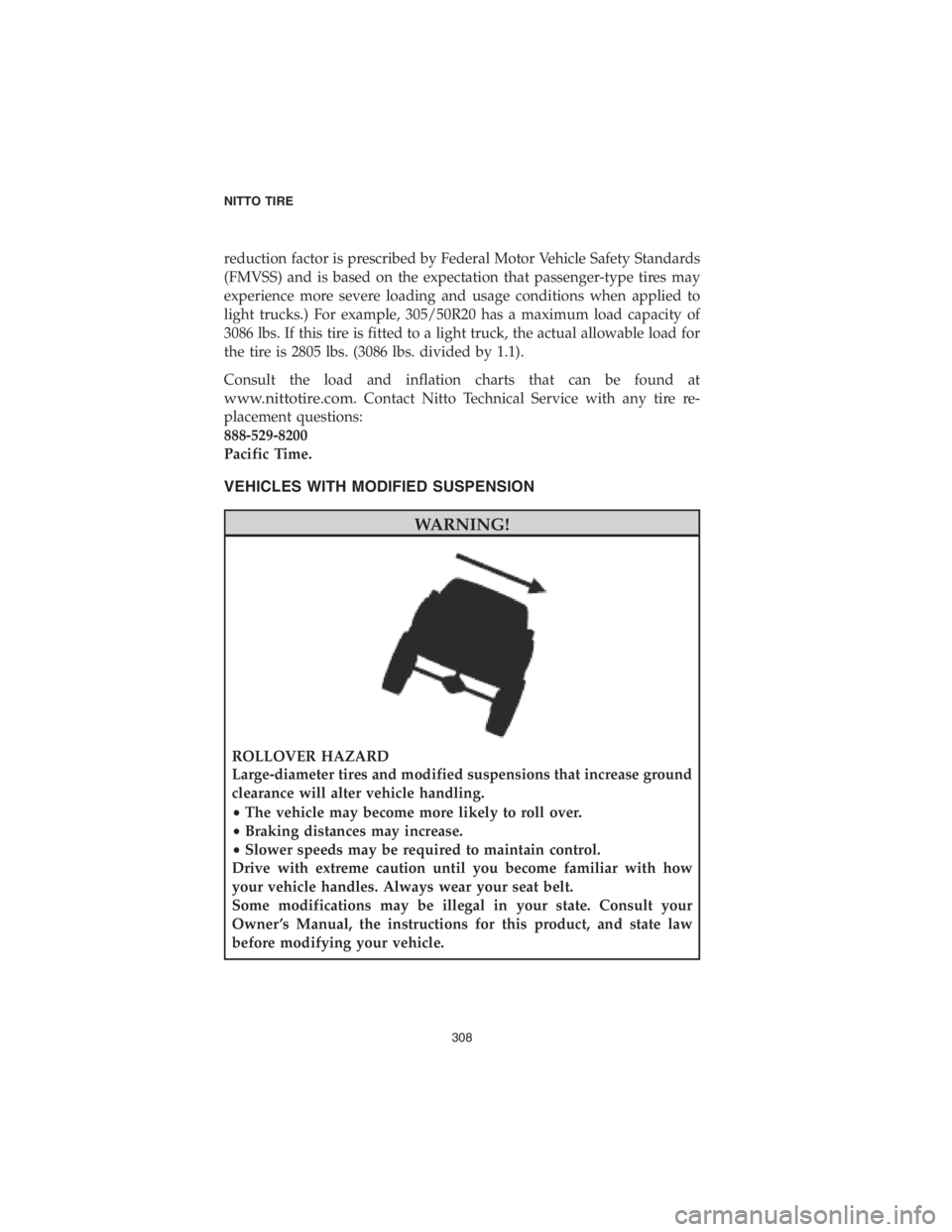
reduction factor is prescribed by Federal Motor Vehicle Safety Standards
(FMVSS) and is based on the expectation that passenger-type tires may
experience more severe loading and usage conditions when applied to
light trucks.) For example, 305/50R20 has a maximum load capacity of
3086 lbs. If this tire is fitted to a light truck, the actual allowable load for
the tire is 2805 lbs. (3086 lbs. divided by 1.1).
Consult the load and inflation charts that can be found at
www.nittotire.com. Contact Nitto Technical Service with any tire re-
placement questions:
888-529-8200
Pacific Time.
VEHICLES WITH MODIFIED SUSPENSION
WARNING!
ROLLOVER HAZARD
Large-diameter tires and modified suspensions that increase ground
clearance will alter vehicle handling.
•The vehicle may become more likely to roll over.
•Braking distances may increase.
•Slower speeds may be required to maintain control.
Drive with extreme caution until you become familiar with how
your vehicle handles. Always wear your seat belt.
Some modifications may be illegal in your state. Consult your
Owner ’s Manual, the instructions for this product, and state law
before modifying your vehicle.
NITTO TIRE
308